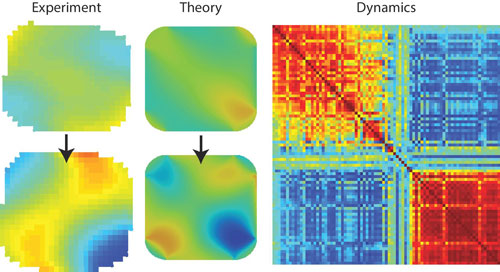| Posted: Feb 02, 2016 |
Hydrogen uptake causes molecular 'avalanches' in palladium nanoparticles
(Nanowerk News) Imagine a sponge that could soak up a thousand times its own volume in water. Now imagine how effective that sponge would be if it could store hydrogen instead of water, giving researchers an alternative to compressed air cylinders for storing the gas.
|
|
Palladium, a precious metal closely related to platinum, is that sponge. Unlike any other element, it takes up hydrogen at room temperature and pressure. In a recent study, scientists at the U.S. Department of Energy’s (DOE) Argonne National Laboratory have gained new insight into how this uptake of hydrogen occurs, realized how it impacts the atomic structure of the palladium, and identified key properties of how this form of hydrogen storage could work in the future.
|
|
When hydrogen is cycled into the palladium nanoparticles, it alters and degrades the particles’ structure over time due to strain. “It’s like trying to put your foot in too small of a shoe,” said Argonne postdoctoral researcher Andrew Ulvestad, who was the study’s first author (Nature Communications, "Avalanching strain dynamics during the hydriding phase transformation in individual palladium nanoparticles").
|
 |
| Comparison between experimental and calculated strain distributions in the hydrogen-poor phase. The strains are consistent with a trapped hydrogen-rich surface layer. Middle: Comparison between experimental and calculated strain distributions in the hydrogen-rich phase. The strains are dominated by elastic effects. Right: The time correlations in the displacement field that show evidence of aging and avalanching during the phase transformation.
|
|
In this study, Ulvestad and his colleagues sought to map the change in the strain distribution inside the palladium nanoparticles over time. “If you can see the evolution of the strain distribution, you can tell what the hydrogen inside is doing,” Ulvestad said.
|
|
To do so, the researchers used the coherent high-intensity X-rays produced at the 34-ID-C beamline at the Advanced Photon Source, a DOE Office of Science User Facility located at Argonne.
|
|
In the nanoparticles, the researchers saw, the hydrogen atoms get incorporated into the lattice of the metal atoms that compose the nanoparticle. This, however, is not a uniform process. As the hydrogen is taken up over time, there is eventually a sudden reconfiguration of the hydrogen distribution within the lattice, a process colloquially referred to as “avalanching.”
|
|
According to Ulvestad, the “avalanches” within the nanoparticle lattice may be caused by the hydrogen atoms finding intermediate, or metastable, energy states during the reconfiguration. In large enough particles, the rearrangement of the lattice into these metastable states causes permanent defects to form in the lattice itself. As these defects form, the palladium nanoparticles become less able to take up hydrogen from the environment.
|
|
“The ultimate goal is hydrogen storage or purification, and this research gets us closer to making that a reality,” Ulvestad said. “This work may not be ready to translate to cars quite yet, but there are certain applications on the grid scale that we are beginning to look at.”
|

